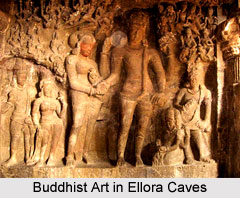The main purpose of Buddhist art in India was to popularise the religion of Buddhism. Buddhist art in India came into being after the historical life of Gautam Buddha during the sixth to fifth century B.C. and then it developed by contact with other cultures as it spread all through Asia and the world.
The presence of Lord Buddha was portrayed by the symbols of empty throne, a pair of foot prints, a lotus, or a Bodhi tree. The sculpture developed later on into more precise and explicit definition of the episodes relating to the life of Lord Buddha and his teachings. It is in north India that the first anthropomorphic representation of Buddha is said to have emerged. The two main proponents of Buddhist art in India is the Gandhara School and the Mathura school of art.Buddhist art flourished in the panorama of Indian art during the Maurya dynasty under the reign of emperor Ashoka, who embraced Buddhism. The several stupas like the one in Sanchi and the pillars adorned with Buddhist symbols were the earliest instances of Buddhist art in India. These stupas comprise a hemispherical dome with a harmika supporting the umbrellas. The sculpture of Bharhut depicts stories from the life of Lord Buddha and also tales from Jataka. The sculpture dealing with the life of Gautam Sakyamuni includes Buddha's enlightenment, the vision of Maya, and the defeat of Mara among others. In the sculptures of Bharhut, Amravati and Sanchi the worship of the Bodhi tree is widely prevalent. The Buddhist art in south India during this era is best represented by the Maha chaitya at Amravati which resembles the art at Bharhut. The Buddhist art at Amravati is noted for its sophistication and elegance.
For more visit the page:
